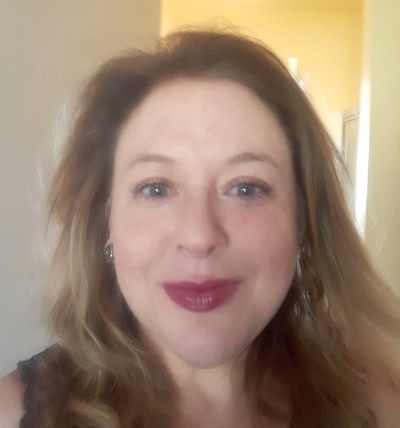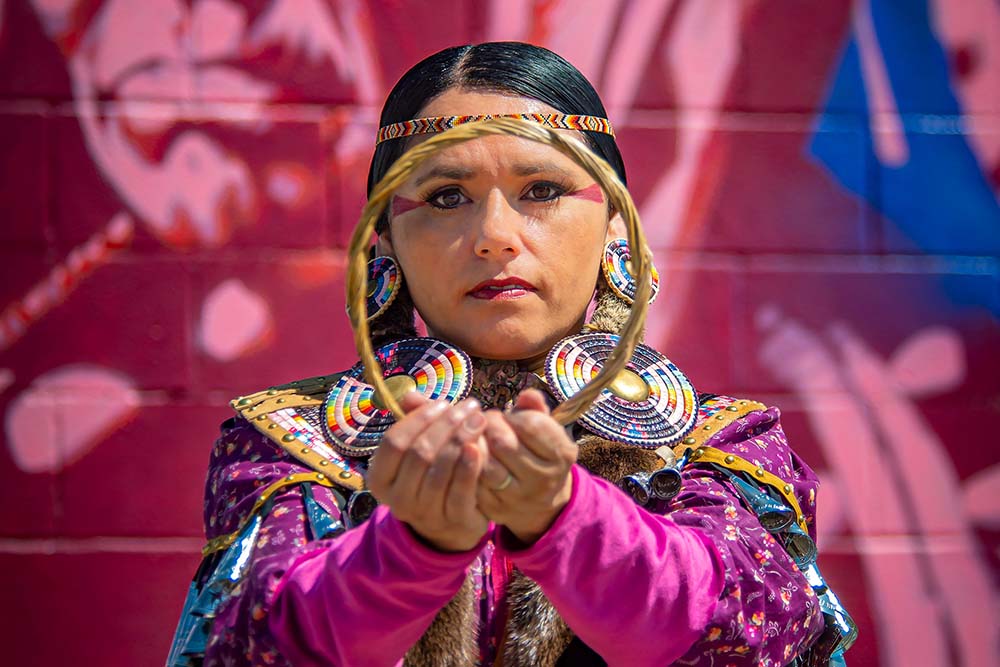
- Details
- By Tamara Ikenberg
This weekend and next week, Indian Country is presenting a beautiful blend of music and art, photography, and sweet surprises.
The cultural mix includes a Tlingit creation story told through glass and sound, Indigenized candy hearts to share with your sweetheart, an interlude with an expert in opera and Oneida pottery, and majestic and medicinal images of a strong and striking Ojibwe superstar.
Native News Online’s event guide is coming up to get this arty party started. Check it out for a glimpse into all the good stuff.
Virtual Artist Discussion with Jennifer Stevens
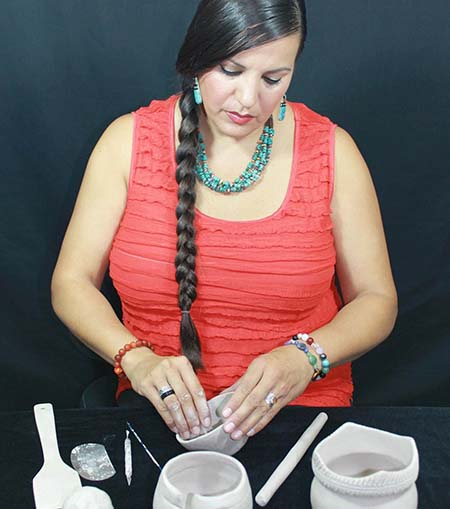 Oneida opera singer and potter Jennifer Stevens will take part in a virtual artist discussion on Zoom hosted by the Mitchell Museum of the American Indian Evanston, Illinois, on Thursday, Jan. 27. (Jennifer Stevens)WHEN: Thursday, Jan. 27, 4 p.m.
Oneida opera singer and potter Jennifer Stevens will take part in a virtual artist discussion on Zoom hosted by the Mitchell Museum of the American Indian Evanston, Illinois, on Thursday, Jan. 27. (Jennifer Stevens)WHEN: Thursday, Jan. 27, 4 p.m.
WHERE: Zoom. Register here.
How does one craft a career equal parts Puccini and Oneida pottery?
You can find out how a passion for European arias and an ancient Indigenous artform can co-exist within one dynamic woman when Oneida-Oglala Lakota potter and opera recitalist Jennifer Stevens opens up about her fascinating life and work during a virtual artist discussion hosted by the Mitchell Museum of the American Indian.
Stevens is keenly aware of the seeming opposition between her two talents.
“They are two extremely different worlds. I have the authentic Native American historical side of me, and then I have this other side of me, where I was studying how to sing in Italian, French, and German,” Stevens told Native News Online.
Stevens’ online discussion is the beginning of a new commitment between herself and the Mitchell. Stevens will be teaching the museum’s Saturday cultural workshops beginning later this year.
As a renowned teacher and researcher of ancient Oneida pottery, Stevens is reviving a long lost Oneida art. Stevens said the Oneida ceased making their utilitarian pots, which were initially made of stone and progressed to clay, in the late 1600s. During that time, the Oneida started trading with European settlers and transitioned to the metal trade pots they introduced.
“A lot of people didn’t know that tribes of the east coast even made pottery,” Stevens said. “The pots were used for cooking, storing food, and also for ceremonies. They were a major part of our life. Our pottery was basically our life sustenance.”
“I research designs, and I recreate them and produce these pots as authentically as possible. It's about education and cultural preservation, which is really essential,” said Stevens, who also makes contemporary art. “I feel like my ancestors are with me when I'm creating them. It's a very beautiful experience. When I teach my students, I remind them that these are sacred items. We're working with our mother earth, we're working with fire. These are all sacred elements to Native American people. It's in our culture.”
As for her operatic side, Stevens performs arias by composers including Puccini and Mozart, and also integrates Indigenous culture into the classical mix.
In addition to performing modern operatic works in Native American languages by other composers, she writes and performs original music and lyrics, and has those lyrics translated into the Oneida and Lakota languages. She’s performed some of these pieces with the Green Bay Symphony Orchestra.
“Historically, there are very few Native American opera singers, and hardly any of them write their own music, much less write opera,” Stevens said. “It's not just me pulling myself out of the roots of my Native American culture and throwing myself into Europe and singing opera. I’m fusing the Native American culture with the European culture through music. It's a lot of fun. I want to share with other people that Native Americans are able to express ourselves as authentically as we can through our art and music, even if it is opera.”
Woodland Sky Native American Dance Company at Crazy Horse Memorial\Michelle Reed in Cowboys & Indians Magazine
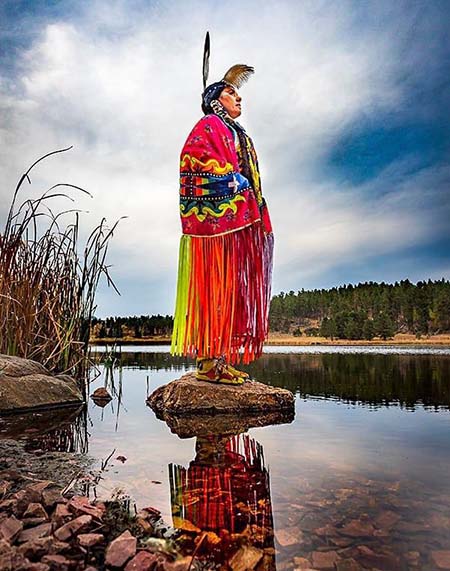 This image of Ojibwe educator, dancer and artist Michelle Reed taken by Chad Coppess, placed first in the Native American category of Cowboy & Indians Magazine's Visions of the West photography competition. Reed's dance troupe The Woodland Sky Native American Dance Company will perform at the Crazy Horse Memorial is Custer, South Dakota on Saturday, Jan. 29. (Chad Coppess)WHEN: Saturday, Jan. 29, 4 p.m.
This image of Ojibwe educator, dancer and artist Michelle Reed taken by Chad Coppess, placed first in the Native American category of Cowboy & Indians Magazine's Visions of the West photography competition. Reed's dance troupe The Woodland Sky Native American Dance Company will perform at the Crazy Horse Memorial is Custer, South Dakota on Saturday, Jan. 29. (Chad Coppess)WHEN: Saturday, Jan. 29, 4 p.m.
WHERE: Crazy Horse Memorial, 12151 Avenue of the Chiefs, Custer, SD; Event page.
In the aptly titled photo “Powerful Connections,” Ojibwe culture-bearer Michelle Reed organically blends in visually and spiritually with a hot pink mural of Lakota woman warrior Redbird.
Taken last year in Eagle Butte, South Dakota, by Chad Coppess, the photo editor of South Dakota Magazine, the image won the grand prize in Cowboys & Indians Magazine’s 2022 Visions of the West photography competition.
For Reed, whose jubilant jingle dress of pink happened to match the mural perfectly, it’s the sweetgrass in her hands that completes the picture of strength and healing.
“Holding that sweet grass up–that medicine–that was a really important part of the photo,” Reed, a dancer, educator, and artist, who travels the country sharing her knowledge and skills, told Native News Online. “And the jingle dress dance is a medicine dance, so, the feeling of that photo was really powerful. Chad is an amazing photographer.”
Adding to Reed and Coppess’ visual victory, another photo of Reed atop a rock in Stockade Lake in the Black Hills won the competition’s Native American category. Both images are featured in the current issue.
This Saturday, visitors to Crazy Horse Memorial in Custer, South Dakota, can see Reed’s vibrant cultural work in action when the troupe she founded, the Woodland Sky Native American Dance Company, takes the Welcome Center Theater stage.
The one-night-only show will showcase Ojibwe, Lakota, Menominee, Potawatomi, Oneida, and Apache dancers. The group represents men’s and women’s Native American styles including traditional, fancy, jingle, grass, woodland and hoop, and it will be Woodland Sky’s first time doing their storytelling through dance at the Memorial.
“It's really amazing that the Crazy Horse Memorial gets performers from all over the world. People come to South Dakota to experience the beauty of the land there, the Black Hills,” Reed said. “It’s different from any other place where I've worked. We're going to take an extra day to check out their museum and see what that's all about.”
Preston Singletary: Raven and the Box of Daylight
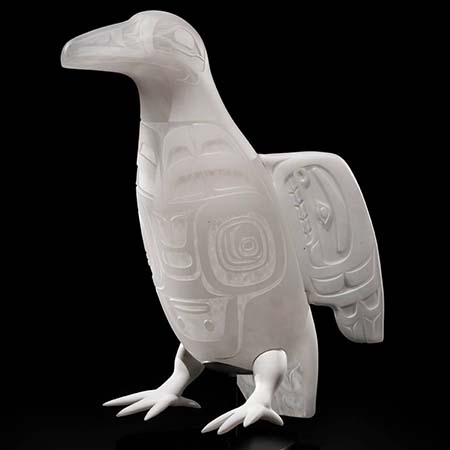 The sculpture White Raven by Tlingit glass artist Preston Singletary is part of Singletary's show Raven and the Box of Daylight, running from Jan. 28, 2022 through Jan. 29, 2023 at the National Museum of the American Indian in Washington D.C. (Preston Simgletary) WHEN: Jan. 28 through Jan. 29. 2023
The sculpture White Raven by Tlingit glass artist Preston Singletary is part of Singletary's show Raven and the Box of Daylight, running from Jan. 28, 2022 through Jan. 29, 2023 at the National Museum of the American Indian in Washington D.C. (Preston Simgletary) WHEN: Jan. 28 through Jan. 29. 2023
WHERE: National Museum of The American Indian, Fourth St. & Independence Ave. SW, Washington DC; Event page
In the Tlingit legend Raven and the Box of Daylight, the winged trickster of southeast Alaska Native lore leads a transformation from light to darkness by gifting the world with the sun, stars, and moon.
Raven’s cosmic contributions are at the heart of Preston Singletary: Raven and the Box of Daylight, a new multi-sensory glass experience at the National Museum of the American Indian.
The show spins the creation story into a spectacle for the eyes and ears, setting the dazzling glass pieces of internationally acclaimed Tlingit artist Singletary against an immersive, layered backdrop of storytelling, sounds of the Pacific Northwest Coast, original music and projected images.
Click here to hear Singletary discuss the exhibit and his career in a conversation hosted by the National Museum of the American Indian.
More Stories Like This
Five Native American Films You Should Watch This Thanksgiving WeekendHeavy metal is healing teens on the Blackfeet Nation
Over 150 Tribal Museums Participate in Fourth Annual Celebration of Native Life
New Book Showcases 250 Images by Indigenous Photographers Spanning Two Centuries
Five Native American Chefs You Should Know
Help us tell the stories that could save Native languages and food traditions
At a critical moment for Indian Country, Native News Online is embarking on our most ambitious reporting project yet: "Cultivating Culture," a three-year investigation into two forces shaping Native community survival—food sovereignty and language revitalization.
The devastating impact of COVID-19 accelerated the loss of Native elders and with them, irreplaceable cultural knowledge. Yet across tribal communities, innovative leaders are fighting back, reclaiming traditional food systems and breathing new life into Native languages. These aren't just cultural preservation efforts—they're powerful pathways to community health, healing, and resilience.
Our dedicated reporting team will spend three years documenting these stories through on-the-ground reporting in 18 tribal communities, producing over 200 in-depth stories, 18 podcast episodes, and multimedia content that amplifies Indigenous voices. We'll show policymakers, funders, and allies how cultural restoration directly impacts physical and mental wellness while celebrating successful models of sovereignty and self-determination.
This isn't corporate media parachuting into Indian Country for a quick story. This is sustained, relationship-based journalism by Native reporters who understand these communities. It's "Warrior Journalism"—fearless reporting that serves the 5.5 million readers who depend on us for news that mainstream media often ignores.
We need your help right now. While we've secured partial funding, we're still $450,000 short of our three-year budget. Our immediate goal is $25,000 this month to keep this critical work moving forward—funding reporter salaries, travel to remote communities, photography, and the deep reporting these stories deserve.
Every dollar directly supports Indigenous journalists telling Indigenous stories. Whether it's $5 or $50, your contribution ensures these vital narratives of resilience, innovation, and hope don't disappear into silence.
 The stakes couldn't be higher. Native languages are being lost at an alarming rate. Food insecurity plagues many tribal communities. But solutions are emerging, and these stories need to be told.
The stakes couldn't be higher. Native languages are being lost at an alarming rate. Food insecurity plagues many tribal communities. But solutions are emerging, and these stories need to be told.
Support independent Native journalism. Fund the stories that matter.
Levi Rickert (Potawatomi), Editor & Publisher

